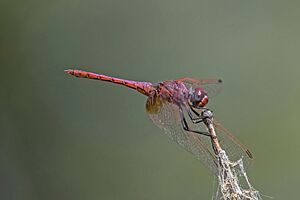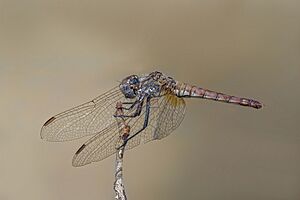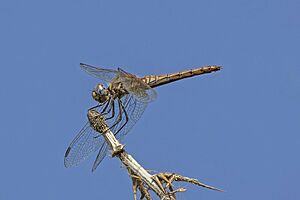Violet dropwing facts for kids
Quick facts for kids Violet dropwing |
|
|---|---|
 |
|
| Male | |
 |
|
| Mature female in Cyprus | |
| Conservation status | |
| Scientific classification |
The Trithemis annulata, often called the violet dropwing, is a type of dragonfly. Other names for it include the violet-marked darter or purple-blushed darter. These dragonflies are called "dropwings" because they quickly lower their wings right after they land. You can find them in most parts of Africa, the Middle East, and southern Europe. Male violet dropwings are violet-red with red veins in their wings, while females are yellow and brown. Both males and females have bright red eyes.
Contents
What Does the Violet Dropwing Look Like?
The violet dropwing is a strong, medium-sized dragonfly. It has a wingspan of about 60 millimeters (2.4 inches).
Male Violet Dropwings
Adult males have a dark red head. Their mouth area is yellow with a brown spot in the middle. Their eyes are red with small white spots on the back edges. The front part of their head is a shiny purplish-red. The top part of their body (thorax) is violet with slightly darker stripes. Their wings have special red veins, and the small, colored spot near the wingtip (pterostigma) is orange-brown. There's also a large orange-brown patch at the base of their back wings. The main body part (abdomen) is quite wide and pinkish-violet. It has purple marks on top of each segment and blackish marks on the last three segments.
Female Violet Dropwings
Females are about the same size as males. However, their body is brownish, and their abdomen is yellow with dark brown marks. Unlike males, their wings do not have red veins, but they do have similar orange-brown patches.
How to Tell Them Apart from Similar Dragonflies
The violet dropwing looks very much like the red-veined dropwing (Trithemis arteriosa). But the red-veined dropwing has a thinner abdomen and a black, wedge-shaped area on each side of the tip of its abdomen.
Where Do Violet Dropwings Live?
You can find Trithemis annulata in most of Africa. They also live in many countries in Europe and Asia, including France, Cyprus, Greece, India, Iran, Iraq, Israel, Italy, Jordan, Kuwait, Lebanon, Mauritius, Oman, Portugal, Qatar, Réunion, Syria, Turkey, United Arab Emirates, and Yemen.
In 2005, they were seen in the Maltese islands, and by 2007, they were breeding there. Because of global warming, these dragonflies are now spreading further north in Europe. In the late 1990s, they moved from southern Spain and Italy into France, and from Greece and Turkey into Central Europe. For example, they have now settled in the area around the River Ebro in northeastern Spain.
Violet Dropwing Life and Habits
The violet dropwing is a very adaptable species. Adult dragonflies can live in many different places, even in dry, grassy areas. You can see them flying near slow-moving rivers, in marshy areas, and next to still ponds. Sometimes, they are even found near salty water, though it's not clear if they can breed there.
Reproduction and Larvae
The young dragonflies, called larvae, grow very quickly. This means these dragonflies can use temporary pools of water for breeding. Female T. annulata dragonflies lay their eggs by flying over the water and dipping the tip of their abdomen into it. The larvae live in the water and are fierce predators, meaning they hunt and eat other small creatures.
Adult Behavior
Male violet dropwings often perch on small branches of bushes near water or on sunny rocks. In the evening, or when the sun is hidden, they move into trees. Adult dragonflies are also predators. They use their excellent eyesight to spot their prey and their legs to catch and carry their victims.
Conservation Status
The Trithemis annulata is a very common species across its wide range. This range includes most of Africa, the Mediterranean region, the Arabian Peninsula, and the Near East. Even though they might face local threats like losing their habitat, overall, their numbers seem to be growing. Because of this, the International Union for Conservation of Nature has listed its conservation status as being of least concern. This means they are not currently at risk of disappearing.



